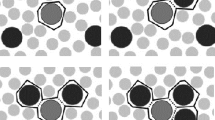Abstract
Proton and deuteron magnetic relaxation rates of the four solutes acetone, acetonitrile, trimethylamine, and tetramethylurea in their aqueous mixtures are reported. For the normal and deuterated organic substances the water was D2O and H2O, respectively. The intermolecular relaxation rates were determined. Experimental results for the self-diffusion coefficients of trimethylamine and tetramethylurea in their aqueous mixtures are also reported. From these results and literature data the A parameter, A=(1/T1)inter·D1/c′1 being a criterion for association, was calculated. We obtained the result that only for the largest solute molecule, i.e. tetramethylurea, A showed the typical concentration dependence indicating solute-solute association. For the other three components self-association is not outside the range of the sensitivity of the present method.
Similar content being viewed by others
References
H. S. Franks and M. W. Evans,J. Chem. Phys. 13, 507 (1945).
F. Franks, inWater. A Comprehensive Treatise, Vol. 4, F. Franks, ed. (Plenum Press, New York, 1975), Chap. 1.
H. G. Hertz,Ber. Bunsenges. Phys. Chem. 68, 907 (1964).
See also: ‘The Hydrophobic Interaction’,Faraday Society Discussions 17, 1982.
A. Ben-Naim,Water and Aqueous Solutions, (Plenum Press, New York, 1974).
L. R. Pratt and D. Chandler,J. Chem. Phys. 67, 3683 (1977);73, 3430, 3434 (1980);J. Solution Chem. 9, 1 (1980).
A. Geiger, A. Rahman, and F. H. Stillinger,J. Chem. Phys. 70, 283 (1979).
A. Ben-Naim,Hydrophobic Interactions, (Plenum Press, New York, 1980).
F. Franks, inWater. A Comprehensive Treatise, Vol. 4, F. Franks, ed. (Plenum Press, New York, 1975), various chapters of Vol. 4.
E. v. Goldammer and H. G. Hertz,J. Phys. Chem. 74, 3734 (1970).
E. v. Goldammer and M. D. Zeidler,Ber. Bunsenges Phys. Chem. 73, 4 (1969).
R. Göller, H. G. Hertz, and R. Tutsch,Pure and Applied Chem. 32, 149 (1972).
H. G. Hertz and R. Tusch,Ber. Bunsenges. Phys. Chem. 80, 1268 (1966).
A. Abragam,The Principles of Nuclear Magnetism, (Clarendon Press, Oxford, 1961).
H. G. Hertz,Nucl. Magn. Reson. Spectroscopy 3, 159 (1967).
H. G. Hertz, R. Tutsch, and N. S. Bowman,J. Chem. Phys. 80, 4117 (1976).
M. D. Zeilder,Ber. Bunsenges. Phys. Chem. 69, 659 (1965).
H. G. Hertz and C. Radle,Ber. Bunsenges. Phys. Chem. 77, 521 (1973).
A. Ben-Naim,J. Chem. Phys. 67, 4884 (1977).
M. C. A. Donkersloot,J. Solution Chem. 8, 293 (1979).
K. J. Patil,J. Solution Chem. 10, 315 (1981).
A. Ben-Naim, in Ref. 4. See also: ‘The Hydrophobic Interaction’,Faraday Society Discussions 17, 1982.
T. C. Farrar and E. D. Becker,Pulse and Fourier Transform NMR, (Academic Press, New York, 1971).
E. D. Stejskall and J. E. Tanner,J. Chem. Phys. 42, 288 (1965).
R. Mills and H. G. Hertz.J. Phys. Chem. 84, 220 (1980).
H. G. Hertz and M. D. Zeilder,Ber. Bensenges. Phys. Chem. 68, 821 (1964).
M. M. Silva, Thesis, Karlsruhe (1977).
K. Sasaki and K. Arakawa,Bull. Chem. Soc. Japan 46, 2738 (1973).
H. G. Hertz and H. Leiter,Z. Phys. Chem. NF, in press.
J. Timmermans,Physico-Chemical Constants of Binary Systems (Interscience Publishers, New York).
H. J. Bender and H. G. Hertz,Ber. Bensenges. Phys. Chem. 81, 468 (1977).
V. Berg, H. G. Hertz, and R. Tutsch,Ber. Bensenges. Phys. Chem. 80, 1278 (1976).
W. Koch and H. G. Hertz,Z. Phys. Chem. NF 130, 139 (1982).
W. Koch, H. Leiter, and H. G. Hertz,J. Solution Chem. 10, 419 (1981).
C. Albayrak, H Leiter, and H. G. Hertz, to be published.
D. W. McCall and D. C. Douglass,J. Phys. Chem. 71, 987 (1967).
G. Roux, D. Roberts, G. Perron, and J. E. Desnoyers,J. Solution Chem. 9, 629 (1980).
Author information
Authors and Affiliations
Additional information
On leave from Department of Chemistry, Institute of Science, Nagpur-1, India.
Rights and permissions
About this article
Cite this article
Leiter, H., Patil, K.J. & Hertz, H.G. Search for hydrophobic association between small aprotic solutes from an application of the nuclear magnetic relaxation method. J Solution Chem 12, 503–517 (1983). https://doi.org/10.1007/BF00651701
Received:
Accepted:
Issue Date:
DOI: https://doi.org/10.1007/BF00651701




